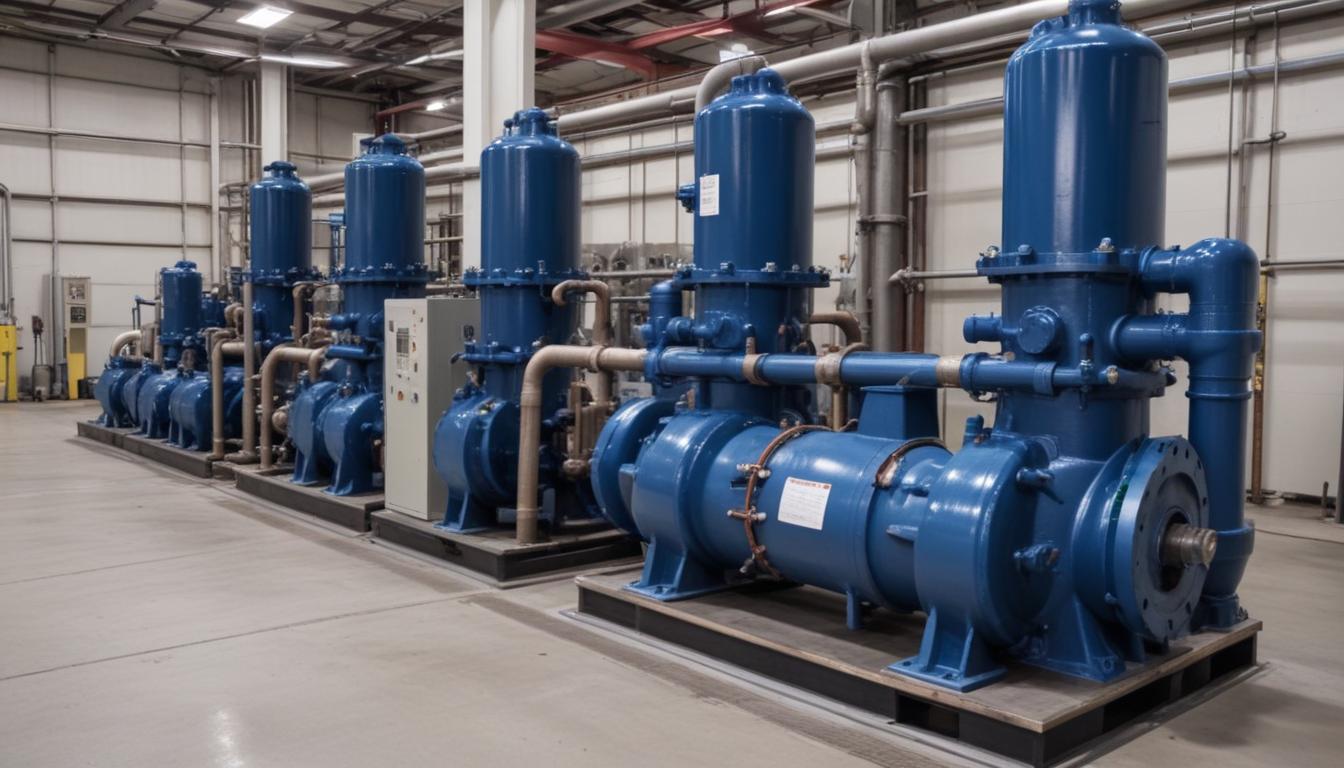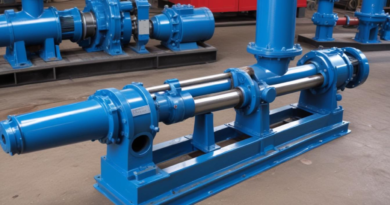how to perform pump thermal maintenance
Thermal pump systems play a critical role in various industrial and commercial applications by efficiently transferring heat to maintain optimal operational conditions. These systems are composed of several key components that work in unison to ensure effective thermal management.
Core Components:
- Pump: Facilitates the movement of the heat transfer fluid throughout the system.
- Heat Exchanger: Transfers heat between the fluid and the surrounding environment without direct contact.
- Control Unit: Monitors and regulates the system’s performance parameters.
- Sensors: Detect temperature variations and provide real-time data to the control unit.
- Piping: Connects all components, ensuring seamless fluid flow.
Understanding the operation of thermal pump systems involves recognizing the interplay between these components. The pump circulates the heat transfer fluid, which absorbs or dissipates heat as needed. The heat exchanger then facilitates the transfer of this heat to or from the environment, depending on the system’s requirements. The control unit, supported by sensor data, adjusts the pump’s operation to maintain desired temperature levels, ensuring the system responds dynamically to changing conditions.
Types of Thermal Pump Systems:
- Closed-Loop Systems: Utilize a sealed circuit where the heat transfer fluid is recirculated continuously.
- Open-Loop Systems: Involve the continuous intake and discharge of fluid from an external source.
- Hybrid Systems: Combine features of both closed and open-loop systems to optimize performance.
Each type of system has its specific applications and advantages, making it essential to select the appropriate configuration based on the operational demands and environmental conditions.
The importance of comprehending thermal pump systems lies in its direct impact on effective pump thermal maintenance. A thorough understanding enables the implementation of proper maintenance procedures, ensuring reliability and longevity of the system. Proper maintenance not only prevents unexpected downtimes but also enhances energy efficiency, contributing to cost savings and sustainable operations.
| Component | Function |
|---|---|
| Pump | Circulates heat transfer fluid through the system. |
| Heat Exchanger | Facilitates heat transfer between fluids and the environment. |
| Control Unit | Manages system parameters and responds to sensor inputs. |
| Sensors | Monitor temperature and other critical variables. |
| Piping | Ensures the efficient flow of the heat transfer fluid. |
By mastering the fundamentals of thermal pump systems, professionals can execute effective pump thermal maintenance procedures, ensuring systems operate at peak performance and mitigating potential issues before they escalate.
safety precautions
Prior to initiating any maintenance tasks, it is crucial to implement comprehensive safety measures to protect personnel and ensure the integrity of the thermal pump system. Adhering to these precautions minimizes the risk of accidents and promotes a safe working environment.
- Lockout/Tagout (LOTO) Procedures: Ensure that the pump and associated equipment are properly shut down and isolated from all energy sources. Apply appropriate locks and tags to prevent accidental reactivation during maintenance.
- Personal Protective Equipment (PPE): Wear necessary PPE, including safety goggles, gloves, protective footwear, and flame-resistant clothing, to safeguard against potential hazards such as chemical exposure, electrical shocks, and mechanical injuries.
- Ventilation: Confirm that the work area is well-ventilated to prevent the accumulation of harmful fumes or vapors, especially when working with refrigerants or other volatile substances.
- Tool Inspection: Use only properly maintained and inspected tools and equipment. Faulty tools can lead to malfunctions or injuries during maintenance procedures.
- Training and Authorization: Ensure that all personnel involved in pump thermal maintenance are adequately trained and authorized to perform the tasks. Proper training reduces the likelihood of errors and enhances overall safety.
- Emergency Procedures: Familiarize yourself with the location of emergency shutoff switches, first aid kits, and fire extinguishers. Prompt access to these resources is essential in the event of an incident.
- Clear Communication: Maintain clear and effective communication among team members. Use standardized signals or communication protocols to coordinate activities and respond swiftly to any issues that arise.
Implementing these safety precautions is of paramount importance in pump thermal maintenance procedures. Not only do they protect personnel from potential hazards, but they also help maintain the operational integrity of the thermal pump system. Neglecting safety measures can lead to serious injuries, equipment damage, and costly downtime, undermining the reliability and efficiency of the system.
| PPE Type | Purpose |
|---|---|
| Safety Goggles | Protect eyes from chemical splashes and debris. |
| Gloves | Shield hands from cuts, abrasions, and chemical exposure. |
| Protective Footwear | Guard against foot injuries from heavy objects and slippery surfaces. |
| Flame-Resistant Clothing | Provide protection in environments with potential fire hazards. |
| Hearing Protection | Reduce exposure to high noise levels during equipment operation. |
Regularly reviewing and updating safety protocols is essential to adapt to any changes in the maintenance environment or procedures. By prioritizing safety, organizations can ensure that pump thermal maintenance tasks are conducted smoothly, efficiently, and without incident.
inspection and assessment
A comprehensive evaluation is essential to ensure the longevity and efficiency of thermal pump systems. This involves systematically examining each component to identify potential issues before they escalate into significant problems. The following steps outline a robust inspection and assessment process:
- Visual Inspection: Begin with a thorough visual examination of the entire system. Look for signs of corrosion, leaks, or physical damage on the pump, heat exchanger, piping, and other vital components. Pay close attention to areas where different materials connect, as these are common points for wear and tear.
- Performance Analysis: Assess the operational performance by comparing current metrics with historical data. Key performance indicators include flow rate, pressure levels, and temperature differentials. Deviations from baseline values may indicate underlying issues that require attention.
- Seal and Gasket Examination: Inspect all seals and gaskets for signs of deterioration or leakage. Compromised seals can lead to fluid loss and reduced system efficiency, necessitating timely replacement to prevent further damage.
- Electrical Component Check: Evaluate the condition of electrical connections, wiring, and control units. Ensure that all connections are secure and free from signs of overheating or corrosion. Malfunctioning electrical components can disrupt system operations and pose safety hazards.
- Sensor Verification: Test the accuracy and responsiveness of all sensors integrated into the system. Reliable sensor data is crucial for the control unit to maintain optimal performance. Calibrate or replace sensors as needed to ensure precise monitoring.
- Structural Integrity Assessment: Examine the structural components, including support frameworks and mounting brackets, for stability and integrity. Weak or unstable structures can affect the alignment and functionality of the entire system.
- Fluid Quality Testing: Analyze the quality of the heat transfer fluid to detect contamination or degradation. Contaminated fluid can impair heat transfer efficiency and cause wear on internal components. Implement appropriate filtration or fluid replacement procedures if necessary.
Implementing a structured inspection and assessment regimen is a cornerstone of effective pump thermal maintenance. Regular evaluations help in identifying minor issues before they develop into major faults, thereby reducing downtime and maintenance costs. Moreover, consistent monitoring ensures that the system operates within its designed parameters, maintaining optimal efficiency and reliability.
| Inspection Area | Key Focus Points |
|---|---|
| Visual Inspection | Corrosion, leaks, physical damage |
| Performance Analysis | Flow rate, pressure levels, temperature differentials |
| Seals and Gaskets | Deterioration, leakage |
| Electrical Components | Connections, wiring condition, control unit functionality |
| Sensors | Accuracy, responsiveness, calibration status |
| Structural Integrity | Stability of support frameworks, mounting brackets |
| Fluid Quality | Contamination levels, degradation indicators |
By adhering to these inspection and assessment procedures, maintenance teams can uphold the importance of proactive pump thermal maintenance. This not only enhances the system’s reliability and efficiency but also extends its operational lifespan, ultimately contributing to more sustainable and cost-effective operations.
cleaning and lubrication
 Maintaining cleanliness and proper lubrication of the thermal pump system is crucial for ensuring optimal performance and longevity. Effective cleaning removes contaminants that can hinder heat transfer and cause wear, while appropriate lubrication minimizes friction and prevents component degradation. Adhering to systematic procedures during these tasks is essential to uphold the importance of pump thermal maintenance.
Maintaining cleanliness and proper lubrication of the thermal pump system is crucial for ensuring optimal performance and longevity. Effective cleaning removes contaminants that can hinder heat transfer and cause wear, while appropriate lubrication minimizes friction and prevents component degradation. Adhering to systematic procedures during these tasks is essential to uphold the importance of pump thermal maintenance.
- Cleaning Procedures:
- Disassembly: Carefully disassemble the pump and related components to access areas prone to dirt accumulation. Ensure all connections are marked and documented to facilitate accurate reassembly.
- Removal of Debris: Use appropriate tools, such as brushes and compressed air, to eliminate dirt, scale, and other deposits from the pump casing, impellers, and heat exchanger surfaces. Pay special attention to corners and crevices where contaminants can accumulate.
- Cleaning Agents: Apply suitable cleaning agents that are compatible with the materials of the pump components. Avoid harsh chemicals that may cause corrosion or damage. For stubborn deposits, consider using mechanical cleaning methods in conjunction with chemical agents.
- Rinsing: Thoroughly rinse all cleaned parts with deionized water to remove any residual cleaning agents or loosened debris. Ensure that no cleaning agents remain, as they can interfere with lubrication and system performance.
- Drying: Allow all components to dry completely before proceeding to lubrication. Use air drying or low-heat methods to prevent thermal stress or warping of parts.
- Lubrication Procedures:
- Selection of Lubricants: Choose high-quality lubricants that are specifically formulated for thermal pump systems. Consider factors such as viscosity, thermal stability, and compatibility with pump materials.
- Application: Apply lubricants to all moving parts, including bearings, seals, and shafts, following manufacturer recommendations. Use precision tools to ensure the correct amount is applied without over-lubricating, which can attract contaminants.
- Lubrication Frequency: Establish a regular lubrication schedule based on the pump’s operating conditions and manufacturer guidelines. High-demand systems may require more frequent lubrication to maintain optimal performance.
- Inspection During Lubrication: While lubricating, inspect components for signs of wear or damage. Address any irregularities immediately to prevent further deterioration and ensure the reliability of the system.
Tools and Materials Required:
| Tool/Material | Purpose |
|---|---|
| Brushes | Remove dirt and debris from surfaces |
| Compressed Air | Blow out loose particles and aid in drying |
| Cleaning Agents | Dissolve and remove stubborn deposits |
| Deionized Water | Rinse components without leaving mineral residues |
| Lubricants | Reduce friction and protect moving parts |
| Precision Applicators | Ensure accurate application of lubricants |
| Personal Protective Equipment (PPE) | Protect against chemical exposure and physical hazards |
Implementing a structured approach to cleaning and lubrication not only enhances the efficiency of the thermal pump system but also extends its operational lifespan. Regular maintenance in these areas prevents the buildup of harmful substances and ensures that all moving parts function smoothly, thereby reducing the likelihood of unexpected failures. By prioritizing these procedures, organizations can maintain the reliability and effectiveness of their thermal pump systems, ultimately supporting sustainable and cost-effective operations.
testing and monitoring
Regular evaluation of system performance is essential to ensure the continued efficiency and reliability of thermal pump systems. Implementing robust testing and monitoring procedures allows for the early detection of potential issues, facilitating timely interventions that can prevent costly downtime and extend the lifespan of the equipment.
Key Testing Procedures:
- Flow Rate Measurement: Assess the volume of heat transfer fluid being circulated to ensure it meets the design specifications. Deviations can indicate blockages or pump performance issues.
- Pressure Testing: Monitor the pressure levels within the system to identify leaks or weaknesses in piping and components. Maintaining optimal pressure is crucial for effective heat transfer.
- Temperature Monitoring: Continuously track the temperature at various points in the system to ensure that heat exchange is occurring as intended. Abnormal temperature readings can signal inefficiencies or potential failures.
- Vibration Analysis: Analyze the vibration patterns of the pump and associated machinery. Excessive vibrations may indicate mechanical imbalances or wear in moving parts.
- Electrical Inspections: Examine electrical connections and components for signs of wear, overheating, or corrosion. Reliable electrical systems are vital for the control unit and sensor accuracy.
- Leak Detection: Utilize specialized equipment to identify and locate leaks in the system. Early detection of leaks helps prevent fluid loss and environmental contamination.
- Thermal Imaging: Employ thermal cameras to visualize heat distribution and identify hotspots or cold spots within the system, which can indicate areas requiring maintenance.
Monitoring Technologies:
Modern thermal pump systems benefit from advanced monitoring technologies that provide real-time data and analytics. These technologies enhance the ability to maintain optimal performance and address issues proactively.
- SCADA Systems: Supervisory Control and Data Acquisition (SCADA) systems offer comprehensive monitoring capabilities, allowing for the centralized control and analysis of system parameters.
- IoT Sensors: Internet of Things (IoT) sensors enable continuous data collection and remote monitoring, facilitating immediate responses to any detected anomalies.
- Data Logging: Implementing data logging solutions helps track historical performance trends, aiding in predictive maintenance and long-term efficiency assessments.
- Automated Alerts: Configure automated alert systems to notify maintenance personnel of critical deviations, ensuring swift action to mitigate potential issues.
Essential Tools and Equipment:
| Tool/Equipment | Purpose |
|---|---|
| Flow Meters | Measure the flow rate of the heat transfer fluid. |
| Pressure Gauges | Monitor pressure levels within the system. |
| Thermometers and Thermal Cameras | Track temperature distributions and identify hotspots. |
| Vibration Analyzers | Detect and analyze vibration patterns in machinery. |
| Leak Detectors | Identify and locate fluid leaks within the system. |
| Multimeters | Assess the condition of electrical components and connections. |
| Data Loggers | Record and store system performance data over time. |
Best Practices for Effective Monitoring:
- Establish Baseline Performance Metrics: Determine the normal operating parameters of the system to identify deviations effectively.
- Regular Calibration: Ensure that all monitoring instruments are accurately calibrated to provide reliable data.
- Scheduled Testing: Implement a consistent testing schedule to maintain ongoing assessment of system health.
- Data Analysis: Analyze collected data to identify trends, predict potential failures, and optimize maintenance schedules.
- Integrate Monitoring Systems: Use integrated monitoring solutions to centralize data collection and streamline maintenance workflows.
- Train Personnel: Ensure that maintenance teams are proficient in using monitoring tools and interpreting data to make informed decisions.
Implementing comprehensive testing and monitoring procedures is a cornerstone of effective pump thermal maintenance. The importance of these practices lies in their ability to enhance system reliability, optimize performance, and reduce operational costs. By leveraging advanced technologies and adhering to best practices, organizations can ensure that their thermal pump systems operate at peak efficiency, thereby supporting sustainable and uninterrupted operations.




